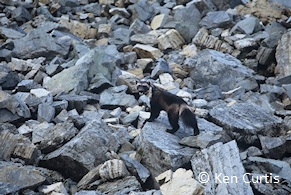Estimates of wolverine density have ranged widely. Magoun (1985) in arctic Alaska and Copeland (1996) in Idaho calculated densities, based on reproductive potential and home range size, of 7–21/1000 km2 and 9–11/1000 km2, respectively. Hornocker and Hash (1981) and Quick (1953) reported population density estimates, based on capture and snow-tracking data, of 15/1000 km2 in northwest Montana and 4.8/1000 km2 in British Columbia, respectively. Banci (1987) estimated Yukon wolverine densities, based on capture data, at 5.6/1000 km2. Home range estimators may inject bias into a density estimate due to variability in sample size and home range estimation technique, which may preclude comparison to other regions.
Estimates based on probability sampling of tracks in snow have produced values that account for variability around the estimate. Probability sampling using line transects in south-central Alaska resulted in estimates of 4.7–5.2 wolverines/1000 km2 (Becker et al. 2004). Those using quadrat sampling in south-central Alaska and northern Yukon resulted in estimates of 3.0–9.7 wolverines/1000 km2 (Golden et al. 2007, Becker and Golden 2008). Estimates based of tracking in snow allow sampling over large areas and provide a snapshot of wolverine density but require good snow, flying, and sightability conditions that can limit applicability.
Other estimates based on mark-recapture of tagged wolverines and on spatial capture-recapture techniques also produced density estimates that contain estimates of variance. Lofroth and Krebs (2007) used capture-recapture of live-trapped wolverines and mark-resight of wolverines by using remote cameras in British Columbia. From their estimates of 5.1–7.8 wolverines/1000 km2 for two study areas, they used wolverine habitat ratings to develop a range of density estimates for the entire province of 0.3–6.2 wolverines/1000 km2. Magoun et al. (2010) used a remote camera array and a spatial capture-recapture model to estimate 9.7 (5.9–15.0) wolverines/1000 km2 in southeast Alaska.
In Scandinavia, wolverine density based on the average number of active den sites (Landa et al. 1998) was estimated at 10–14 wolverines/1000 km2 (Persson et al. 2006). Other estimates for this region, based on capture-recapture of wolverine fecal DNA, indicated population densities that were approximately 35% higher than those derived from den sites counts (Flagstad et al. 2004).
Not all methods of estimating density are suitable for all regions across wolverine range. Additional testing and replicate sampling are necessary to determine the accuracy and precision of all methods used to estimate wolverine density.
<< Back to Species Account Overview
______________________________________
Literature Cited:
Banci, V. 1987. Ecology and behaviour of wolverine in Yukon. Thesis, Simon Fraser University, Burnaby, British Columbia, Canada.
Becker, E. F., H. N. Golden, and C. L. Gardner. 2004. Using probability sampling of animal tracks in snow to estimate population size. Pages 248–270 in W. L.
Thompson, editor. Sampling rare or elusive species: concepts and techniques for estimating population parameters. Island Press, Washington, D. C., USA.
Becker, E. F., and H. N. Golden. 2008. Results of recent wolverine survey of GMU 14C. Alaska Department of Fish and Game, Anchorage, Alaska, USA. 10 pages.
Copeland, J. P. 1996. Biology of the wolverine in central Idaho. Thesis, University of Idaho, Moscow, Idaho, USA.
Flagstad, Ø., E. Hedmark, A. Landa, H. Broseth, J. Persson, R. Andersen, P. Segerström, and H. Ellegren. 2004. Colonization history and noninvasive monitoring of a reestablished wolverine population. Conservation Biology 18:676–688.
Golden, H. N., J. D. Henry, E. F. Becker, M. I. Goldstein, J. M. Morton, D. Frost, Sr., and A. J. Poe. 2007. Estimating wolverine Gulo gulo population size using quadrat sampling of tracks in snow. Wildlife Biology 13 (Suppl. 2):52–61.
Hornocker, M. G., and H. S. Hash. 1981. Ecology of the wolverine in northwestern Montana. Canadian Journal of Zoology 59:1286–1301.
Landa, A., J. Tufto, R. Franzen, T. Bo, M. Linden, and J. E. Swenson. 1998. Active wolverine Gulo gulo dens as a minimum population estimator in Scandinavia. Wildlife Biology 4:159–168.
Lofroth, E. C., and J. Krebs. 2007. The abundance and distribution of wolverines in British Columbia, Canada. Journal of Wildlife Management 71:2159–2169.
Magoun, A. J. 1985. Population characteristics, ecology, and management of wolverines in northwestern Alaska. Dissertation, University of Alaska, Fairbanks, Alaska, USA.
Magoun, A. J., P. Valkenburg, R. E. Lowell, C. D. Long, and J. Long. 2010. Associations and movement patterns of reproductive female wolverines (Gulo gulo luscuc) on the Southeast Alaska mainland. The Wolverine Foundation, Kuna, Idaho, USA. 181 pages.
Persson, J., A. Landa, R. Andersen, and P. Segerström. 2006. Reproductive characteristics of female wolverines (Gulo gulo) in Scandinavia. Journal of Mammalogy 87:75–79.
Quick, H. F. 1953. Wolverine, fisher, and marten studies in a wilderness region. Transactions of the North American Wildlife Conference 18:513–532.
 Because of the wolverine’s reproductive potential and niche in the environment, its abundance across its circumboreal range is low relative to carnivores of similar size. Consequently, population densities, or number of wolverines per unit area, are also generally low. A common way of reporting density that allows easy comparison is number of animals per 1000 square kilometers (or km
Because of the wolverine’s reproductive potential and niche in the environment, its abundance across its circumboreal range is low relative to carnivores of similar size. Consequently, population densities, or number of wolverines per unit area, are also generally low. A common way of reporting density that allows easy comparison is number of animals per 1000 square kilometers (or km Follow
Follow